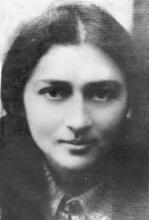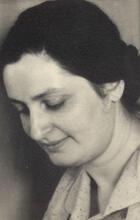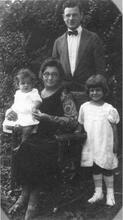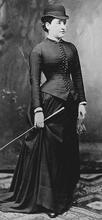Izieu, Women of
In April 1944, Nazi Gestapo Chief Klaus Barbie raided a home for Jewish children in Izieu, France. Forty-four children from the home were immediately deported to Auschwitz and murdered there. Five Jewish women displayed remarkable courage in this tragedy at Izieu: Sabine Zlatin, Léa Feldblum, Suzanne Levan-Reifman, Fourtunée Benguigui, and Ita-Rosa Halaunbrenner. Zlatin, Feldblum, and Levan-Reifman worked as the home’s director, teacher, and doctor, respectively. Benguigui and Halaunbrenner were both mothers of children who lived at Izieu. All five women played critical roles testifying against Barbie in his 1987 trial and advocated for his capture and conviction. While the tragedy of Izieu is known primarily as a story of children, the bravery of these women is also a significant part of the tale.
On April 6, 1944, Klaus Barbie (1913–1991), Chief of the Nazi Gestapo in Lyons during the German occupation of France, raided a home for Jewish children in Izieu, a remote hilltop village overlooking the valley of the Rhône (70 km east of Lyons). This action was to become one of the most infamous symbols of Nazi brutality and, ironically, the single count (of crimes against humanity) for which Barbie, torturer and murderer of Jewish men, women, and children, but most excoriated as the executioner of Résistance hero Jean Moulin, was tried and convicted some forty-three years later. Barbie’s telex to the Office for Jewish Affairs, stating “This morning the Jewish children’s home ‘colonie enfant’ in Izieu, Ain was cleaned out. ... Neither cash nor other valuables could be secured. Transport to Drancy to follow on 4/7/44,” served as conclusive evidence in the trial. On that early April morning, as the children and their counselors were eating breakfast, Barbie and his men rounded up forty-five youngsters (the one non-Jewish child was subsequently released to his cousin in town) and seven adults (Léon Reifman alone was able to escape through a second-floor window), loading them “like sacks of potatoes” onto waiting trucks toward their inevitable deaths in Auschwitz or elsewhere. The tragedy of Izieu is known primarily as a story of children, but the remarkable courage and heroism of five Jewish women is also a significant part of that tale.
Sabine Zlatin
Sabine Zlatin, affectionately called “La Dame d’Izieu,” was the founder and director of the small OSE children’s home, and her absence that day (she was in Montpellier seeking safer quarters for the children) allowed her to deliver powerful testimony at Barbie’s trial in 1987. More important, Zlatin (who had lost her husband Miron in the raid) devoted the rest of her life to the memory of these children and to human rights. She was the ingenious and indefatigable creator of what is today the Maison d’Izieu-Mémorial des Enfants Juifs Exterminés on the site of the original farm. It opened in April 1994 as a center for learning and celebration as well as for memory and social responsibility—in Zlatin’s words, “a place that would symbolize the denunciation of crimes against humanity.”
Born Sabine Chwast in Warsaw in 1907, the youngest of twelve children in a Jewish family, she became a Bund member and social activist while still in her teens. Imprisoned after a demonstration, she resolved to leave Poland and emigrated to France where she met Miron Zlatin, a Russian-Jewish agronomy student at the University in Nancy. They married in 1927 and moved to Landas to start a poultry farm; in 1939 they became French citizens. Sabine trained with the Red Cross when war broke out and worked as a military nurse in Montpellier until she was forced to leave in 1941 due to Vichy’s anti-Jewish laws. Then, wanting to help Jewish women and children, she began work at the Oeuvre de secours aux enfants (OSE) in the prefecture of Hérault, rescuing children who were internees in the camps of Agde and Rivesaltes, often by hiding them in her cloak until they reached safety.
The children’s home was a result of the German occupation of the French zone in 1942; the Zlatins, seeking shelter in what was then the Italian zone, brought seventeen children to the sub-prefect of Belley, who directed them to the farmhouse in Izieu. The OSE connection was kept secret for security reasons and the home’s official title was Settlement for Refugee Children from the Hérault. Mme Zlatin organized the farmhouse refuge, kept its true function disguised, procured identity and ration cards, coordinated the teachers and counselors, and acted as the children’s guardian and emotional support. Her collection of the children’s drawings and letters (many of them testaments to the strong, affectionate bond between Sabine and “her” children) is now in the Bibliothèque Nationale in Paris. Immediately after the war she helped survivors readjust and then lectured throughout Europe about the home at Izieu and the fate of the children. She moved to Paris where she remained for the rest of her life and revived her early interest in painting, becoming an acknowledged and prolific artist.
In her 1992 memoir (she died in September 1996 at the age of 89), she wrote: “I would like to explain the idea I had, right from the start, about what Izieu ought to become. ... The fate of these forty-four children of Izieu must move visitors, young and old alike. But many other crimes against humanity were committed in the world before this, and many will follow. Resistance to fanatical ideologies is the sole mode of struggle against regimes which commit such crimes. Vigilance is the responsibility of everyone charged with protecting the rights of children, the rights of all human beings. More than a simple memorial or a museum, this house must be a vibrant center for all those who struggle in the mode expressed by John Donne: ‘No man is an Island, entire of itself. ... Any man’s death diminishes me, because I am involved in Mankind.’”
Léa Feldblum
Twenty-four year-old Léa Feldblum was the sole survivor of Barbie’s raid on the children’s home and was thus able to testify in 1987 (she died two years later) as to how they perished in Auschwitz. Ironically, it was Léa’s safe-conduct allowing her to escort the children to more secure quarters that Sabine was seeking in Montpellier. Described by Serge Klarsfeld as “good incarnate,” her exemplary devotion to the children survived the innumerable tragedies of her life. Born in 1918, she and her family moved to Antwerp, Belgium, in 1929. In 1940 they fled to southwest France; both parents died in Montpellier while her sister Rywka and brother Moses were deported in 1942 to Auschwitz, where they were murdered. Léa worked as a teacher-counselor at Palavas-les-Flots, Campestre à Lodève, Chambéry, and finally Izieu, bringing to each place a warmth and generosity that made the children adore her.
After the raid, Léa was interrogated at Fort Montluc and then transferred to Drancy where she insisted on accompanying the children to Auschwitz. (She had refused two opportunities to cross into Switzerland.) Upon arrival, the children were torn away from her for immediate execution; Léa survived, emigrated to Palestine, married, and was widowed two years later by her husband’s death in the struggle for Israeli independence. By the time she came to Lyons to bear witness at Barbie’s trial she was a grandmother. She had continued to devote her life to the education of children and the enduring image of her comes from Izieu’s teacher Gabrielle Perrier: “All the children were her little pals; she loved them dearly and they felt the same way. The little ones always surrounded her, clambering onto her lap ... while she presented each new child to me, her hand gently caressing their heads.”
Suzanne Levan-Refiman
Suzanne Levan-Reifman, the doctor at the home, substituted as director when Mme Zlatin was away. She was born in Romania in 1907 and had brought her ten-year-old son Claude (who resembled his Vietnamese father) and her aging parents to stay in the idyllic mountain retreat while she took care of the Izieu family’s medical needs. Only her brother Léon, who was visiting that day at the beginning of Easter vacation, was able to hear her warning and jump to safety. At Auschwitz she refused to be separated from her son and thus accompanied him and the other children to the gas chamber. Strikingly beautiful and gifted as a healer, Dr. Levan-Reifman was remembered by Sabine Zlatin as “a warm and capable presence who would make the children leave the infirmary with smiles on their faces.”
Fortunée Benguigui
Two mothers of Izieu children, Fortunée Benguigui and Ita-Rosa Halaunbrenner, were instrumental in bringing Klaus Barbie to justice. Fortunée Chouraki Messouda Benguigui was born in 1904 in Oran, Algeria. She was arrested in Marseilles in 1943, believing her three sons to be safe at Izieu; her baby daughter Yvette was entrusted to local farmers and survived the raid. She lost her sons—Jacques (12), Richard (7), and Jean-Claude (6)—in the raid, which took place while she was a prisoner in Auschwitz. Having survived brutal medical experiments, she was assigned to a sorting shed where she learned of her children’s deaths by finding her son’s hand-knit sweater on the shoulders of a camp doctor’s teenage boy.
Although Fortunée had been declared seventy-five percent incapacitated at the end of the war, she agreed to go to Munich in September 1971, to join Beate Klarsfeld in protesting against the German government’s dismissal of criminal proceedings against the former Lyons Gestapo head. The two women sat on the steps of the Palace of Justice with Mme Benguigui holding a sign in one hand: “I will continue my hunger strike until the Munich prosecutor’s office reopens proceedings against Klaus Barbie, the murderer of my three children.” In the other hand she held a photo of her three little boys.
The women’s success resulted in both a renewed effort to prosecute the war criminal and an important lead as to his whereabouts in La Paz, Bolivia. At Barbie’s trial some sixteen years later, Fortunée stated that she testified “to honor the memory of my three sons; ... I survived [the medical] tests because I was sure my children were safe. ... [When I saw the sweater in Auschwitz] I realized something had happened and started crying.” Benguigui died less than two years later, in December 1988, on the day that she was awarded the Legion of Honor medal.
Ita-Rosa Halaunbrenner
Ita-Rosa Halaunbrenner’s thriving family of five children was abruptly reduced to two by the actions of Klaus Barbie. Her husband Jacob and their eldest son Léon were arrested by the Lyons Gestapo in October 1943. Léon (14) was deported to slave labor in the Polish salt mines where he was worked to death; Jacob was executed at Gestapo headquarters in December (seventeen machine-gun bullets were in his neck and chest). Ita-Rosa (née Hoffner) was born in Poland in August 1904, while Jacob was born in Austria. Between 1941 and 1943 their status as foreigners in France led to the family’s being interned in several camps in the southern zone until they were assigned housing in Lyons. During the arrest, Ita-Rosa screamed at Barbie’s men in Yiddish to let her son go free, but Barbie would have none of it. He shoved her aside and then drew his revolver, pummeling her hand to make her let go.
As she would testify at the trial, “What’s dearer to a mother than her children? I had five, and my profession was to be their mother. ... When they took away my husband and oldest son, I was left without money, without a job, family, or friends. ... It broke my heart to see Mina (8) and Claudine (5) leave with a stranger, but I knew that [at Izieu] at least they would be fed and would not be cold.” The two remaining children, Alexandre (11) and Monique (3), stayed with their mother and survived the war. Thus it was that in March 1972 this “woman of extraordinary courage” accompanied Beate Klarsfeld to La Paz, where they chained themselves to a bench opposite Klaus Barbie’s office building in the center of town to demonstrate for the war criminal’s extradition. Mme Halaunbrenner’s sign read: “People of Bolivia, help me! Mothers, I ask only for justice. May Barbie-Altmann, murderer of my husband and three of my children, be judged.” The necessary machinery for the Gestapo chief’s return to France was put in motion, although it took another fifteen years before he was brought to trial, with Mme Halaunbrenner dying almost two years later (May 1989).
Both Benguigui and Halaunbrunner were honored by Serge Klarsfeld in the dedication to his book about another Izieu child, Gyorgy Halpern: “Through their courage they joined the legend of Jewish mothers. Their support of Beate Klarsfeld in Germany, right up until Bolivia in 1971 and 1972 and later at the trial of Barbie in 1987, demonstrates how the murder of their children led them to an exemplary action of justice and memory.”
On June 18, 1981, a Memorial to the Jews Deported from France was unveiled at Rogelit (a Cooperative smallholder's village in Erez Israel combining some of the features of both cooperative and private farming.moshav in the Judean Hills) Israel. Commissioned by The Association of Sons and Daughters of the Jews Deported from France (the Klarsfelds’ organization), the monument lists the names of almost eighty thousand Jews martyred by antisemitic persecution during the war. Appropriately, Fortunée Benguigui and Ita-Rosa Halaunbrenner were chosen for the honor of dedicating the memorial. In his plea on behalf of the children of Izieu during Barbie’s trial, Serge Klarsfeld emphasized the women’s courage: “[T]hese mothers of Izieu have raised their heroism to the level of their children’s tragedy. ...[D]espite their age and their health, inspired by their desire for justice, these mothers expressed themselves not with simple words alone but with extreme actions. ... They dared to do what so many others were not inclined to even attempt. ... Through their valiant actions they have reached out across time to their children. They have helped to bring back the children of Izieu into the light of memory.”
Causse, Rolande. Les Enfants d’Izieu. Paris: 1989.
Houzé, Kathel, and Jean-Christophe Bailly. The Izieu children’s colony, 1943-1944. Editions Libel, 2012.
Kahn, Annette. Why My Father Died: A Daughter Confronts Her Family’s Past at the Trial of Klaus Barbie. New York: 1991.
Klarsfeld, Serge. The Children of Izieu: A Human Tragedy. New York: 1985.
Klarsfeld, Serge. French Children of the Holocaust: A Memorial. New York: 1996.
Klarsfeld, Serge. Remembering Georgy: Letters From the House of Izieu. New York: 2001.
Lühe, Ulrike, and Romain Ledauphin. “From the forerunners of document collection to the trial of Klaus Barbie and beyond: the transitional justice journey of the Izieu telegram.” The International Journal of Human Rights (2020): 1-27.
Zlatin, Sabine. Mémoires de la ‘Dame d’Izieu. Paris: 1992.








